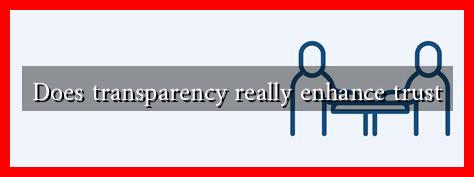-
Table of Contents
Does Transparency Really Enhance Trust?
In an age where information is abundant and skepticism is rampant, the concept of transparency has emerged as a cornerstone for building trust in various sectors, including business, government, and personal relationships. But does transparency genuinely enhance trust, or is it merely a buzzword that fails to deliver on its promises? This article delves into the nuances of transparency, exploring its impact on trust through examples, case studies, and research findings.
The Definition of Transparency
Transparency refers to the openness and clarity with which organizations or individuals communicate their actions, decisions, and processes. It involves sharing information that is relevant and accessible to stakeholders, thereby allowing them to understand the rationale behind decisions. Transparency can manifest in various forms, including:
- Open financial reporting
- Clear communication of policies and procedures
- Public access to decision-making processes
- Engagement with stakeholders through feedback mechanisms
The Link Between Transparency and Trust
Trust is a fundamental element in any relationship, whether personal or professional. Research indicates that transparency can significantly enhance trust, but the relationship is complex. Here are some key points to consider:
- Increased Accountability: When organizations are transparent, they are more accountable for their actions. This accountability fosters trust among stakeholders who feel assured that their interests are being considered.
- Reduction of Misinformation: Transparency helps to combat misinformation. When organizations share accurate and timely information, it reduces the likelihood of rumors and speculation, which can erode trust.
- Empowerment of Stakeholders: Transparency empowers stakeholders by providing them with the information they need to make informed decisions. This empowerment can lead to increased loyalty and trust.
Case Studies: Transparency in Action
Several organizations have successfully leveraged transparency to build trust with their stakeholders. Here are a few notable examples:
1. Buffer
Buffer, a social media management platform, is renowned for its transparency. The company openly shares its revenue, employee salaries, and even its decision-making processes. This level of openness has fostered a strong sense of trust among its users and employees, leading to a loyal customer base and a positive workplace culture.
2. Patagonia
Patagonia, an outdoor clothing brand, is another example of transparency enhancing trust. The company is committed to environmental sustainability and openly shares its supply chain practices. By being transparent about its environmental impact, Patagonia has built a loyal customer base that trusts its commitment to ethical practices.
Statistics Supporting Transparency
Research supports the notion that transparency enhances trust. A study by the Edelman Trust Barometer found that 81% of consumers need to trust a brand to buy from them. Furthermore, 63% of consumers believe that companies should be transparent about their business practices. These statistics underscore the importance of transparency in fostering trust in today’s marketplace.
The Limitations of Transparency
While transparency can enhance trust, it is not a panacea. There are limitations to consider:
- Overload of Information: Too much transparency can lead to information overload, making it difficult for stakeholders to discern what is truly important.
- Misinterpretation: Transparency does not guarantee understanding. Stakeholders may misinterpret the information shared, leading to confusion and mistrust.
- Context Matters: The effectiveness of transparency in building trust can vary depending on the context and the relationship between the parties involved.
Conclusion
In conclusion, transparency can significantly enhance trust, but it is not a one-size-fits-all solution. Organizations that embrace transparency can foster accountability, reduce misinformation, and empower stakeholders, ultimately leading to stronger relationships. However, it is essential to strike a balance, as excessive transparency can lead to confusion and misinterpretation. As we navigate an increasingly complex world, the pursuit of transparency remains a vital strategy for building and maintaining trust.



